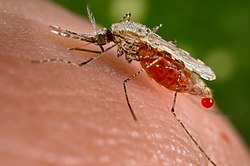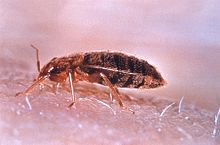
Back دموية التغذية Arabic Hematofàgia Catalan Sání krve Czech Hämatophagie German Αιματοφαγία Greek Hematofagia Spanish Hematofagia Basque خونخوردن Persian Hematofaxia Galician מוצצי דם HE



Hematophagy (sometimes spelled haematophagy or hematophagia) is the practice by certain animals of feeding on blood (from the Greek words αἷμα haima "blood" and φαγεῖν phagein "to eat"). Since blood is a fluid tissue rich in nutritious proteins and lipids that can be taken without great effort, hematophagy is a preferred form of feeding for many small animals, such as worms and arthropods. Some intestinal nematodes, such as Ancylostomatids, feed on blood extracted from the capillaries of the gut, and about 75 percent of all species of leeches (e.g., Hirudo medicinalis) are hematophagous. The spider Evarcha culicivora feeds indirectly on vertebrate blood by specializing on blood-filled female mosquitoes as their preferred prey.[1] Some fish, such as lampreys and candirus; mammals, especially vampire bats; and birds, including the vampire finch, Hood mockingbird, Tristan thrush, and oxpeckers, also practise hematophagy.
- ^ Jackson, R. R.; Nelson, X. J. (2012). "Evarcha culicivora chooses blood-fed Anopheles mosquitoes but other East African jumping spiders do not". Medical and Veterinary Entomology. 26 (2): 233–235. doi:10.1111/j.1365-2915.2011.00986.x. hdl:10092/9753. PMID 22032682. S2CID 25520447.
© MMXXIII Rich X Search. We shall prevail. All rights reserved. Rich X Search